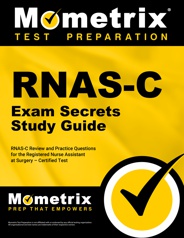The Registered Nurse Assistant at Surgery – Certified (RNAS-C) credential is used to validate your knowledge and skills, achieve your personal goals, and provide evidence to employers that you have met the academic and national standards for first assistants at surgery.
Click “Start Test” above to take a free RNAS-C practice test, and check out our premium-quality RNAS-C test prep resources by clicking below!
Exam Eligibility
The eligibility requirements for the RNAS-C exam vary depending on whether you are an RN or Advanced Practice Registered Nurse (APRN). Requirements that are the same for both the RN and APRN include:
- A current, unrestricted RN license
- Advanced Cardiovascular Life Support (ACLS), Basic Life Support, or Cardiopulmonary resuscitation (CPR) certification
- Completion of a formal Registered Nurse First Assistant (RNFA) program
- At least 120 documented hours of first assisting practice as an RNFA during the intraoperative phase. These hours must be within the two years immediately preceding your application.
In addition, RNs must hold a current Certified Perioperative Nurse (CNOR) certificate, and APRNs must be certified as Advanced Practice Registered Nurse by an accredited certification program.
RNAS-C Exam Outline
The RNAS-C exam contains 200 multiple-choice questions, and you will be given a 3-hour time limit.
The exam is split into four, 50-question sections.
I. Surgical Patient Care
The questions in this section are designed to assess your knowledge and skills in the following areas:
- Infection prevention
- Microbiology
- Diagnostic testing
- Pharmacology
- Principles of perioperative practice
- Legal aspects of perioperative practice
- Workplace safety
II. Surgical Skill
The questions in this section are designed to assess your knowledge and skills in the following areas:
- Surgical instrumentation
- Tissue handling
- Tissue retraction
- Hemostasis
- Suturing
- Surgical drains
- Surgical complications
III. Anatomy and Physiology
The questions in this section are designed to assess your knowledge and skills in the following areas:
- Anatomy and physiology
- Surgical pathology
- Wound closure
IV. Procedure Considerations
The questions in this section are designed to assess your knowledge and skills in the following areas:
- Surgical procedures and nursing considerations
- Wound closure
Check out Mometrix's RNAS-C Printed Study Guide
Get practice questions, video tutorials, and detailed study lessons
Get Your Study Guide
Registration
To apply for RNAS-C certification, download the application from the NASC website. Complete the application and submit the $425 payment to the NASC office via mail, email, or fax. If you register online, your application is taken 24 hours a day, seven days a week.
Once your application is accepted, you are provided with an account with Prolydian. Schedule your testing appointment through your Prolydian account. You must schedule your exam within four months of submitting your application, or your fees are forfeited.
Test Day
On test day, you should arrive at the testing center about 30 minutes before the scheduled appointment. Upon arrival, you will be asked to provide a printed copy of your admission ticket and two forms of valid identification.
You will also be asked to store all personal items in a secure locker before entering the testing area.
Once the check-in process is complete and you are fully approved for testing, you will be led to the testing station and given a brief tutorial on the testing system.
RNAS-C Scores
You must answer at least 70% of the questions correctly to pass the exam.
Test results are emailed within 72 hours of testing.
Retaking the Exam
If you do not pass the exam, you may retake it after a 45-day waiting period. You cannot take the test more than three times within 12 months.
FAQs
Q
How many questions are on the RNAS-C exam?
A
There are 200 questions on the exam.
Q
How long is the RNAS-C exam?
A
The time limit for the exam is 3 hours.
Q
What is the passing score for the RNAS-C exam?
A
To pass the exam, you must answer at least 70% of the questions correctly.
Q
How much does the RNAS-C exam cost?
A
The examination fee is $425.
